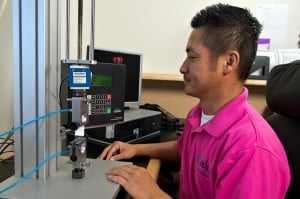Welcome to DDLs PackReview series on Seal Strength Testing
In this video, DDL Package Engineers Scott Levy and Pete Johnson sat down to talk about the most frequently asked questions they receive on ASTM F88 Seal Strength testing. Some of the questions covered include:
- What is seal strength testing?
- Why use it?
- What are the different techniques?
- What equipment is used?
- Can anybody do ASTM F88 Seal Strength Testing?
- What are the major issues DDL sees with its customers?
“Seal strength testing is a uniform way to understand the strength of two materials, along with being able to understand what strength it takes to open that package,” says Scott.
Many have asked, why use ASTM F88 Seal Strength? Scott said, “It is important for the manufacturer to know what type of strengths they are putting on a particular package. You want to have a sturdy seal that isn’t too difficult to peel apart and want to have enough strength on a package so it does not cause for a stability breach, which means they are not forming a seal.”
There are three different seal strength techniques to choose from: Technique A which is held up without support; Technique B, which is holding it between your fingers as a supporting function; and, Technique C which is supported by a backing plate. Technique A and Technique C are the two most commonly used.
 When choosing a technique the key word is consistency. When you are looking to do ASTM F88 Seal Strength testing, choose a technique and stay with it throughout the project so you can get consistent results. If you do decide to change techniques in the middle of a project your data will change as well.
When choosing a technique the key word is consistency. When you are looking to do ASTM F88 Seal Strength testing, choose a technique and stay with it throughout the project so you can get consistent results. If you do decide to change techniques in the middle of a project your data will change as well.
While anybody can do an ASTM F88 Seal Strength test with a tinsel tester, the key thing is making sure it is properly calibrated to the proper load cell and you have performed a test method validation.
Lastly, one of the biggest issues that come up is when manufacturers set a minimum of one pound specification and they don’t know where that one pound specification came from. Minimum specifications from seal strength derive from process validation. Setting up a validation you need to understand your low, nominal and high. How much strength does it take to pull this product apart?
The second issue is choosing from Technique A verses Technique C. Technique A will give you a result and Technique C will give you almost two times that result. “If someone is used to seeing high values and they end up using Technique A and see lower values, well there’s a problem,” Scott explained. The consistency aspect of speed rate, technique you run and understanding what your minimum specification is going to be is going to help you get the correct data from the ASTM F88 Seal Strength Testing and what you are looking for.
Please contact us if you have further questions about ASTM F88 Seal Strength testing, or would to speak to one of our package engineers about an upcoming test.